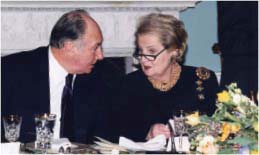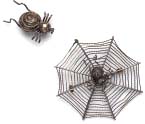Read My Pins (15 page)
Authors: Madeleine Albright

Yasser Arafat and I conferring by phone with President Clinton. I spent many hours wrangling with the Palestinian leader about the need for compromise in the Middle East. My pin reflected my mood.
Bee, designer unknown.

REUTERS

Feature articles appeared in the foreign and domestic press, and—to my embarrassment—total strangers began walking up and trying to give me pins.
One instance in particular bears recounting. On July 4, 2000, I was privileged to stand on the steps of the home of Thomas Jefferson, the first secretary of state, to witness hundreds of people take their oath of allegiance as new citizens of the United States. A naturalized citizen myself, I was moved by the ceremony and astonished, as always, by the remarkable diversity in background of the American people. Appropriately, attendees were given small American flags to wave, but at the accompanying reception my attention was drawn to a more dramatic version of the flag. Two elegant Virginia ladies, Julann Griffin and her sister, Maureen, were introduced to me, the former wearing a jumbo star-spangled U.S. flag brooch. When I complimented Julann, she offered me the pin. I had to say no but later accepted when she repeated her kind gesture after I left office. That was when Mrs. Griffin informed me that the brooch had originally been a gift from her ex-husband, the one and only Merv Griffin, who credited her with thinking up the game show
Jeopardy
. For me ever since, the question “What is Monticello?” has been linked to “The place where I got my fantastic pin.”
Throughout my life with brooches, there has been one overriding challenge: how to wear them.
I long ago stopped wearing long necklaces, because they bounced around. I never liked the appearance of pins on lapels, especially on me. Pins on coats did not suit me either. I always preferred to wear brooches on the left side, thinking they looked better there, but the larger ones got in the way when I carried a purse with a strap. Smaller pins gradually appealed less because I had grown accustomed to what one reviewer of my books referred to as my “big honker brooches.”

My Monticello flag,
Butler & Wilson
.

Hats, like jewelry, can be expressive. I spent my teenage years in Colorado and developed a fondness for Stetsons. I rekindled this affection when traveling as secretary of state, both because I liked the look and because I had more bad hair days than I could count.
Cowgirl hat, Ultra Craft.

U.S. DEPARTMENT OF STATE

U.S. DEPARTMENT OF STATE
I like to arrange my bees and flower in different ways. One evening, while sitting with Aga Khan at a State Department dinner on cultural diplomacy, I had the bees in an ascending line.
There was also the dilemma of how to arrange multiple pins. Some went together naturally, such as the zebras that I wore to a meeting with Nelson Mandela. Other combinations took more imagination—for example, bees approaching a sunflower. It was fun experimenting with various arrangements, but the practice threatened to consume too much energy. This is beside the fact that my clothes began to resemble dartboards, so perforated were they by the pins; eventually, I had to wear more and even bigger ones to mask the destruction.
At the same time, I had to deal with what a male friend described to me in jest as the Hooters issue. At Morey Junior High School in Denver, I had worn a blouse with a decoration that included two spiderwebs made of white stitching. I also owned a pair of small bug pins that I did not hesitate to place at the center of the spiderwebs, which were located on the left and right sides of my torso, face-front, breast-high. Given my age at the time, no one pointed out that they resembled pasties. With maturity comes growth, however, and as I traveled the world as a diplomat, I wanted people to look at my pins without embarrassing either the observers or me. So I wore the pins higher and higher up.

U.S. DEPARTMENT OF STATE
Spiders and their web, reproductions, The Metropolitan Museum of Art.

Flower with four bees, Joseff of Hollywood.

Nelson Mandela represented a new hope in Africa in the mid-1990s. I wore my favorite zebra pins when I met him at his estate in Pretoria, South Africa, in December 1997.
From left: Medium zebra, Ciner; large zebra, KUO; small zebra, designer unknown.

